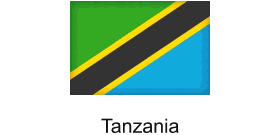 Dodoma’s Tourism Transformation: New Infrastructure and Attractions Set to Redefine Tanzania’s Heart
Dodoma’s Tourism Transformation: New Infrastructure and Attractions Set to Redefine Tanzania’s Heart
The Tanzanian government has embarked on a bold initiative to elevate Dodoma and the broader central region into a premier tourism destination, targeting both domestic and international visitors. This comprehensive strategy is already reshaping the landscape of central Tanzania, with a focus on enhancing infrastructure, enriching visitor experiences, and unlocking the region’s untapped tourism potential in areas such as Mkungunero, Swaga Swaga Reserve, and the ancient Kondoa Irangi rock paintings [[1]](https://allafrica.com/stories/202509300060.html)[[2]](https://dailynews.co.tz/tanzania-seeks-to-turn-dodoma-into-a-central-zones-tourism-hub/).
Strategic Partnerships and Infrastructure Upgrades
At the heart of this transformation is a collaborative effort between the Ministry of Natural Resources and Tourism, the Tanzania Forest Services Agency (TFS), the Tanzania Tourism Board (TTB), and private sector stakeholders. Their shared vision is to ensure that Dodoma’s attractions are supported by modern roads, upgraded hotels starting from three-star standards, essential social services, and a diverse range of tourism products and activities. This approach is designed to make the region more accessible and appealing to a wider spectrum of travelers, from adventure seekers to cultural enthusiasts.
Dainess Kunzugala, Acting Director of Tourism Development, emphasized that the government’s commitment extends beyond infrastructure. The strategy also aims to foster a vibrant tourism ecosystem by encouraging investment in hospitality, improving service quality, and developing new experiences that showcase the unique character of Dodoma and its surroundings.
Private Sector Engagement and Eco-Tourism Growth
The private sector is playing a pivotal role in this transformation. Joel Massai, Director of Epic Adventures, highlighted the sector’s readiness to collaborate with government agencies to promote and enhance Dodoma’s attractions. This partnership is crucial for driving innovation, marketing, and sustainable development across the region.
Eco-tourism is emerging as a key focus, with TFS Central Zone Senior Assistant Commissioner, Mathew Kiondo, noting that many of Dodoma’s most compelling attractions are located within game reserves managed by TFS. These reserves are being actively developed and protected, offering visitors opportunities to experience Tanzania’s rich biodiversity while supporting conservation efforts.
Heritage and Cultural Tourism: The Kondoa Irangi Paintings
One of Dodoma’s crown jewels is the Kondoa Irangi rock art, a UNESCO World Heritage site renowned for its ancient paintings. These artworks, etched into stone shelters and caves, provide a window into the region’s prehistoric cultures and rituals. The government’s investment in infrastructure and visitor services has already yielded impressive results: domestic tourist numbers at Kondoa Irangi have surged from 1,287 in 2018 to 7,654 in 2024, while international arrivals have climbed from 171 in 2020 to 541 in 2024. This growth underscores the rising appeal of cultural and heritage tourism in central Tanzania.
Major Projects Fueling Regional Connectivity
TTB Central Zone Senior Tourism Officer, George Mwagane, pointed to several national infrastructure projects that are set to further boost Dodoma’s tourism prospects. The ongoing construction of the Standard Gauge Railway (SGR) and the new Msalato International Airport will dramatically improve access to the region, making it easier for both domestic and international travelers to explore Dodoma’s attractions. These projects are expected to act as catalysts for increased visitor numbers and greater investment in the local tourism sector.
Community Engagement and Sustainable Development
The government’s strategy is closely aligned with the principles of sustainable tourism. This was highlighted during the recent celebration of World Tourism Day on September 27, where the theme “Tourism and Sustainable Development” took center stage. More than 40 participants joined a two-day exploration of the historical center of Kolo in Kondoa, reflecting a growing interest in responsible travel and community-based tourism initiatives.
By prioritizing sustainability, the government and its partners are working to ensure that tourism growth benefits local communities, preserves cultural heritage, and protects natural resources for future generations. This approach is particularly relevant for African destinations seeking to balance economic development with environmental stewardship.
Dodoma’s Unique Position in Tanzania’s Tourism Landscape
Dodoma’s central location, combined with its rich tapestry of natural and cultural attractions, positions it as a potential tourism hub for the entire central region. The region’s diverse offerings—from wildlife reserves and ancient rock art to vibrant local cultures—provide a compelling alternative to Tanzania’s traditional safari circuits. As infrastructure improves and new products are developed, Dodoma is poised to attract a broader range of visitors, including those seeking off-the-beaten-path experiences.
Industry leaders believe that Dodoma’s transformation could serve as a model for other regions in Africa, demonstrating how targeted investment, public-private collaboration, and a focus on sustainability can drive tourism growth and regional development.
Looking Ahead: Opportunities for Africa’s Travel Sector
For Africa’s travel professionals, Dodoma’s ongoing evolution offers valuable insights and opportunities. The region’s success in attracting both domestic and international tourists highlights the importance of infrastructure, product diversification, and strategic marketing. As more African destinations invest in similar initiatives, the continent’s tourism landscape is set to become more competitive, dynamic, and resilient.
Dodoma’s journey also signals a broader shift in traveler preferences, with increasing demand for authentic, sustainable, and culturally rich experiences. By staying attuned to these trends and leveraging new developments in regions like Dodoma, Africa’s travel sector can position itself for long-term growth and success in a rapidly changing global market.
